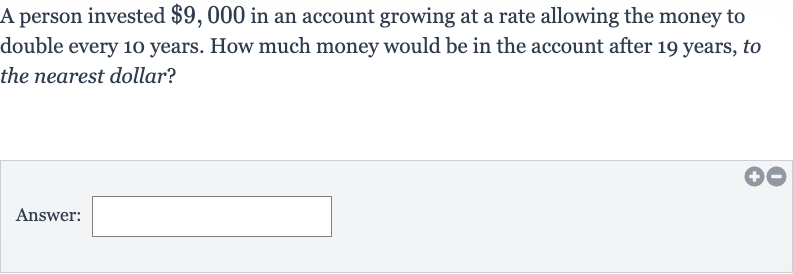Full solution
Q. A person invested in an account growing at a rate allowing the money to double every years. How much money would be in the account after years, to the nearest dollar?Answer:
- Initial Investment and Doubling Period: Determine the initial investment and the doubling period.The initial investment is , and the money doubles every years .
- Number of Doubling Periods: Determine the number of times the initial investment will double in years.The number of doubling periods is calculated by dividing the total time by the doubling period .Since the investment can only double a whole number of times, we need to use the floor function to find the number of complete doubling periods, which is .
- Amount After Complete Doubling Periods: Calculate the amount of money after the complete doubling periods.The formula for exponential growth is , where is the final amount, is the initial amount, is the growth factor ( for doubling), and is the number of doubling periods.After one complete doubling period ( years), the investment will be .
- Growth for Remaining Years: Calculate the growth for the remaining years.There are years left after the first complete doubling period. We need to calculate the growth for these years.The growth rate per year can be calculated using the formula for doubling time: , where is the natural logarithm.We need to solve for , but since we already know the investment doubles every years, we can use the rule of , which is an approximation that states . Therefore, per year.
- Apply Annual Growth Rate: Apply the annual growth rate for the remaining years.The formula for compound interest is , where is the amount of money accumulated after years, including interest, is the principal amount, is the annual interest rate, is the number of times that interest is compounded per year, and is the time the money is invested for.Since the interest is compounded once per year in this case (), the formula simplifies to .
- Final Amount After Years: Calculate the final amount after years.Rounding to the nearest dollar, the final amount is approximately .
More problems from Exponential growth and decay: word problems
QuestionGet tutor help
QuestionGet tutor help
QuestionGet tutor help
QuestionGet tutor help
QuestionGet tutor help
QuestionGet tutor help
QuestionGet tutor help
QuestionGet tutor help
QuestionGet tutor help



